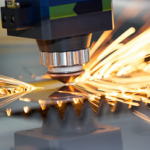CNC (Computer Numerical Control) machining has revolutionized the manufacturing industry, providing a range of techniques that allow for precision, efficiency, and versatility in creating complex parts and products. Whether you’re working with wood, metal, plastics, or composites, selecting the right CNC machining method is crucial to achieving optimal results. Each technique offers unique capabilities and is suited for different materials and design complexities, making it essential to understand their differences and applications.
In this article, we’ll explore various Custom CNC machining techniques, including CNC routing, turning, milling, plasma cutting, laser cutting, and electrical discharge machining (EDM). By understanding the strengths and limitations of each method, you can make informed decisions about which technique is best suited for your specific project requirements. From high-speed metal cutting to intricate wood engravings, we’ll help you understand the diverse world of CNC precision machining to enhance your manufacturing processes.
CNC Machining Techniques Available.
- CNC Router.
CNC routers are versatile machines often used for cutting softer materials like wood, plastics, and foam. These machines excel in creating intricate designs and patterns, making them ideal for woodworking projects, signage, and furniture making. The CNC router uses a rotating cutting tool, or router bit, to remove material, guided by computer-controlled instructions for precise and repeatable results.
When selecting a CNC router, consider the material you will be working with. The router’s power and bit selection will affect the quality and efficiency of your cuts. Additionally, the size of the router’s work area should match the dimensions of your projects. Software compatibility is another crucial factor, as the router must be able to read and execute your design files accurately.
Another benefit of CNC routers is their ability to produce complex shapes and detailed engravings. This capability opens up creative possibilities for custom designs and intricate patterns. However, it’s important to note that while CNC routers are incredibly precise, they may not be suitable for cutting very hard materials like metals, where more robust CNC machines are required.
- CNC Turning.
CNC turning involves rotating the workpiece while a cutting tool is applied to shape it. This method is particularly effective for creating symmetrical objects like shafts, screws, and cylindrical components. CNC lathes are the primary machines used for this process, offering high precision and efficiency for turning operations.
Choosing a CNC lathe depends on the type of materials you plan to work with and the complexity of the parts you need to produce. Lathes come in various sizes, with different capabilities for handling materials ranging from soft plastics to hard metals. Consider the machine’s spindle speed, tooling options, and control system to ensure it meets your project’s requirements.
CNC turning is renowned for its accuracy and repeatability, making it a preferred choice for manufacturing high-precision components. The process allows for the production of both simple and complex geometries with tight tolerances. It’s also highly efficient, as CNC lathes can perform multiple operations in a single setup, reducing production time and costs.
- CNC Milling.
CNC milling uses a rotating cutting tool to remove material from a stationary workpiece, allowing for the creation of complex shapes and features. This method is suitable for a wide range of materials, including metals, plastics, and composites. CNC mills can produce parts with intricate details and high precision, making them ideal for both prototyping and production runs.
When selecting a CNC mill, consider the machine’s spindle speed, tool capacity, and the size of its work envelope. These factors will determine the types of materials you can work with and the complexity of the parts you can produce. Additionally, the software used to program the CNC mill is crucial for achieving the desired level of precision and detail.
CNC milling is highly versatile and capable of producing parts with complex geometries and fine details. This makes it suitable for a wide range of applications, from aerospace and automotive to medical device manufacturing. The ability to use multiple tools in a single operation also enhances productivity and efficiency, allowing for the rapid production of high-quality parts.
- CNC Plasma Cutting.
CNC plasma cutting involves using a high-velocity jet of ionized gas (plasma) to cut through electrically conductive materials such as steel, aluminum, and copper. This method is particularly effective for cutting thick sheets of metal quickly and accurately. CNC plasma cutters are commonly used in metal fabrication shops to produce machinery, structural components, and custom metalwork parts.
When choosing a CNC plasma cutter, consider the thickness and type of materials you will be cutting. The plasma cutter’s power output will determine its ability to cut through various materials efficiently. Additionally, the precision of the cutting head and the accuracy of the CNC control system are important for achieving clean, precise cuts.
One of the main advantages of CNC plasma cutting is its speed and efficiency. Plasma cutters can cut through thick materials much faster than other methods, making them ideal for high-volume production. However, the heat generated during the cutting process can affect the material properties, so it’s essential to consider post-processing requirements for certain applications.
- CNC Laser Cutting.
CNC laser cutting uses a focused laser beam to cut or engrave materials with high precision. This method is suitable for a wide range of materials, including metals, plastics, wood, and even textiles. CNC laser cutters are known for their ability to produce intricate designs and fine details, making them ideal for applications such as signage, jewellery, and custom parts.
When selecting a CNC laser cutter, consider the power of the laser, the size of the cutting bed, and the types of materials you will be working with. Higher-powered lasers are capable of cutting thicker materials, while lower-powered lasers are better suited for engraving and cutting thinner materials. The accuracy of the CNC control system is also crucial for achieving precise cuts and engravings.
CNC laser cutting offers several advantages, including high precision, minimal material waste, and the ability to create complex designs. The non-contact nature of laser cutting also reduces the risk of material deformation. However, it’s important to consider the cost of operation and maintenance, as laser cutters can be more expensive to operate compared to other CNC machines.
- CNC Electrical Discharge Machining (EDM).
CNC Electrical Discharge Machining (EDM) uses electrical discharges or sparks to shape materials, typically hard metals that are difficult to machine with traditional methods. This process is highly precise and can produce complex shapes and fine details. CNC EDM is commonly used in the tool and die industry for making molds, dies, and other intricate components.
When selecting a CNC EDM machine, consider the type of EDM process (wire EDM or sinker EDM) that best suits your needs. Wire EDM is ideal for creating intricate cuts and complex geometries, while sinker EDM is better suited for creating detailed cavities and shapes in hard materials. The machine’s power supply and control system are also important factors to consider.
CNC EDM offers several advantages, including the ability to machine hard materials with high precision and produce complex shapes that would be difficult or impossible with other methods. The process is also non-contact, reducing the risk of material deformation. However, CNC EDM can be slower and more expensive than other CNC machining methods, so it’s important to consider your project’s specific requirements.
- CNC Waterjet Cutting.
CNC waterjet cutting uses a high-pressure jet of water, often mixed with an abrasive substance, to cut through a wide range of materials, including metals, stone, glass, and composites. This method is known for its ability to produce precise cuts without generating heat, making it ideal for materials that are sensitive to high temperatures. CNC waterjet cutters are commonly used in industries such as aerospace, automotive, and architecture.
When choosing a CNC waterjet cutter, consider the material thickness and the type of material you will be cutting. The power and pressure capabilities of the waterjet machine will determine its cutting efficiency and precision. Additionally, the size of the cutting bed and the accuracy of the CNC control system are important factors to ensure the machine meets your project needs.
One of the primary advantages of CNC waterjet cutting is its versatility in cutting various materials with high precision and no heat-affected zones. This process also minimizes material waste and can produce complex shapes and intricate designs. However, waterjet cutting can be slower than other methods like laser cutting, and the cost of operation can be higher due to the use of abrasives and high-pressure water systems.
Conclusion.
Selecting the right precision CNC machining method for your projects involves understanding each technique’s capabilities and limitations. CNC routers are ideal for intricate designs in softer materials, while CNC turning excels at producing symmetrical cylindrical parts. CNC milling offers versatility for creating complex shapes in various materials, and CNC plasma cutting is highly efficient for cutting thick metal sheets. CNC laser cutting provides high precision and is suitable for a wide range of materials, while CNC EDM is perfect for machining hard materials with intricate details.
Carefully considering your project’s material, complexity, precision, and production requirements can help you choose the most appropriate CNC machining method. Each technique has unique advantages, and selecting the right one will ensure the success and efficiency of your machining projects.
Read More: CyberKannadig: A Guide to Kannada Tech Trends and Reviews










